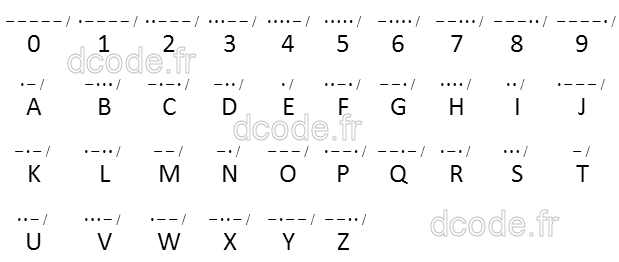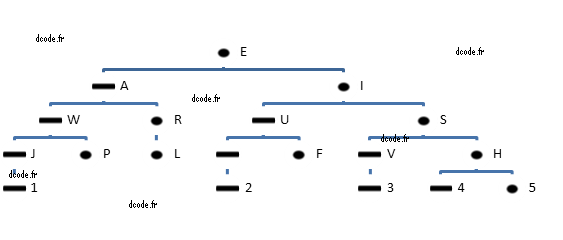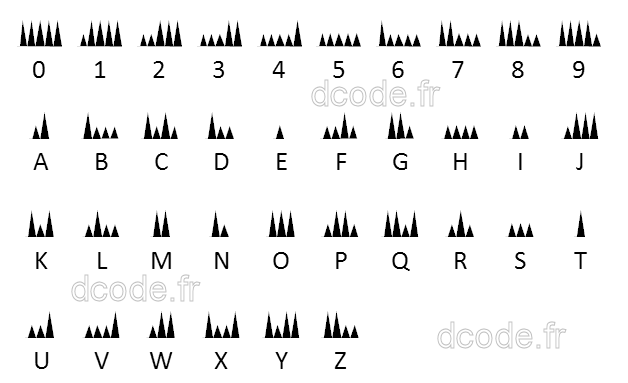Tool to decrypt/encrypt Morse code. Morse code is a system allowing to code a message by short and long impulsion. It is one of the first telecommunication codes.
Morse Code - dCode
Tag(s) : Telecom, Substitution Cipher
dCode is free and its tools are a valuable help in games, maths, geocaching, puzzles and problems to solve every day!
A suggestion ? a feedback ? a bug ? an idea ? Write to dCode!
Morse Code
Morse Code Translator
Morse Encoder
Answers to Questions (FAQ)
What is Morse Code? (Definition)
Morse code is a communication system using short and long pulses (sound, light, electrical signals, etc.) to represent the letters of the alphabet. Adopted worldwide, it played a key precursor role in the history of telecommunications (notably via the telegraph). Although largely supplanted by digital technologies, it retains historical importance in some specific areas, such as military, maritime and radio transmissions, as well as for the famous SOS distress signal.
How to encrypt using Morse Code cipher?
Morse code assigns to each letter, digit, or punctuation sign, a unique combination of signals made of short and long impulsions (usually represented with a dot . and a dash -).
The alphabet or complete table of Morse Code is 
Example: DCODE is coded in Morse language -.. -.-. --- -.. .
Long and short pulses can be electrical, sound (tap, beep), light (flashes/pulses) signals, or any other telecommunication format, anything is possible.
By convention, when writing, each character code is separated by a space and each word is separated by a slash /. Sometimes the characters are separated by a / and the words by a double slash //.
How to decrypt Morse Code cipher?
How to recognize Morse Code ciphertext?
The ciphered message is mainly composed of dots and dashes (or any other couple of characters, or even a triplet of 3 elements if the spaces are coded).
Morse code is usually auditory, a noise/sound made up of long and short tones (like beeps/clicks).
Example: bip biiiip bip = .-.
There is also a luminous variant, the presence of a clignotant light for 2 distinct durations.
Same with syllables in I or E for short and A or O for long.
Example: TATITA = -.- (long, short, long)
Messages sometimes starts with △ -.-.- (start of transmission) and end with ▽ .-.-. (end of transmission) (NB: The code .-.-. is also the code for the character +.)
How to write Morse Code?
There is no standard way to write Morse code since it is primarily an audio signal.
Ideally, the written Morse code should be arranged on the same line. Computers, however, has trouble writing it with the dashes - or _ and the dots . which are not at the same level.
The key is to differentiate the characters: example ▄ (short) and ▄▄▄▄ (long).
How to decipher audio MP3 Morse?
Listen to the message and type simultaneously on a keyboard . (dot) for a short/acute sound and - (dash) for a long/grave one.
If the message is too fast or the sound is noisy, use the spectral analysis tool.
How to decipher Morse without spaces?
Deciphering Morse without a separator is very difficult, a separator is almost essential as the possibilities are exponential.
Example: -.-. (4 characters) can mean 8 different things: C or KE or NN or NTE or TR or TAE or TEN or TETE
Each Morse code character (dash or dot) multiplies the number of possibilities by 2.
Example: 4 characters is therefore 2^4 = 8 possible translations, for 20 characters it is more than 1 million possibilities.
To help decryption dCode offers tools, including a brute-force or dictionary attack. Most methods will favor common letters in French (like E) and filter the results to retain only the most probable ones.
What are the variants of the Morse Cipher?
It is possible to replace the two characters for short and long by others like A and B for example.
A variant of Morse code can reverse the dashes and dots to fool the decoder.
There is a fairly well known overencryption: Fractionated Morse cipher.
How has the Morse alphabet been created?
There are no real rules, however, frequent characters (E, T, A for example) are coded with short signals (1 or 2 impulsions). The less frequent letters are coded with 4 signals maximum, digits with 5.
How to learn the Morse alphabet with mnemonics?
Many methods are used, the principle is to remember 26 words, and with these words find the corresponding association between a letter and its code.
Here is a list of words where each vowel is a dot, each consonant is a dash.
Example: V is described by oooh, that has three vowels and one consonant, so V is coded in Morse with ...-
| A | ax |
| B | beau |
| C | cola |
| D | duo |
| E | e |
| F | uomo |
| G | gnu |
| H | oooa |
| I | io |
| J | iggs |
| K | kim |
| L | olei |
| M | vn |
| N | no |
| O | pls |
| P | ople |
| Q | drug |
| R | ice |
| S | ooo |
| T | t |
| U | ear |
| V | oooh |
| W | arc |
| X | heat |
| Y | hanz |
| Z | blue |
Another method used English pronunciation, stressed syllables standing for a dash and unstressed syllabes stands for a dot.
Example: PSYCHOLOGY, begins with a P, and contains 2 syllables in O, P is then coded in Morse .--.
| A | aGAIN, aPART |
| B | BE a good boy |
| C | COca-Cola, CHARlie-CHARlie |
| D | DRAcula |
| E | eh! |
| F | for the FAIRest |
| G | GOOGOLplex |
| H | holyday in |
| I | i bid |
| J | in JAWS JAWS JAWS |
| K | KANGaROO |
| L | liNOleum |
| M | MAMA |
| N | NAvy, NAzi |
| O | OH MY GOD, OREO |
| P | a PIZZA pie |
| Q | QUEENs WEDding DAY |
| R | roTAtion |
| S | sisisi |
| T | TALL |
| U | uniFORM |
| V | victory V |
| W | the WORLD WAR |
| X | X marks the SPOT |
| Y | WHY dit I DIE |
| Z | ZOO ZOO keeper |
| . | a STOP, a STOP, a STOP |
| , | COMMA, it s a COMMA |
| ? | it s a QUESTION, is it? |
To train yourself, morse code kits are available (for children and adults) to transmit Morse here (affiliate link)
How to send a SOS in Morse?
SOS is coded ...---... (3 shorts, 3 longs, 3 shorts)
How to mark the end of a character in Morse?
In practice, when a letter is finished, the morse encodes the end of a character with empty sounds (silence) or empty visuals a bit long.
When retranscribing, a slash / or any separating character can be added.
Why Morse has this name?
Morse code was developed by Samuel Morse, an American scientist whose name he kept.
Morse therefore has no meaning or relation to the walrus animal (morse in French).
When Morse was invented?
Morse Code was invented in 1835 by Samuel Morse
Source code
dCode retains ownership of the "Morse Code" source code. Any algorithm for the "Morse Code" algorithm, applet or snippet or script (converter, solver, encryption / decryption, encoding / decoding, ciphering / deciphering, breaker, translator), or any "Morse Code" functions (calculate, convert, solve, decrypt / encrypt, decipher / cipher, decode / encode, translate) written in any informatic language (Python, Java, PHP, C#, Javascript, Matlab, etc.) or any database download or API access for "Morse Code" or any other element are not public (except explicit open source licence). Same with the download for offline use on PC, mobile, tablet, iPhone or Android app.
Reminder: dCode is an educational and teaching resource, accessible online for free and for everyone.
Cite dCode
The content of the page "Morse Code" and its results may be freely copied and reused, including for commercial purposes, provided that dCode.fr is cited as the source (Creative Commons CC-BY free distribution license).
Exporting the results is free and can be done simply by clicking on the export icons ⤓ (.csv or .txt format) or ⧉ (copy and paste).
To cite dCode.fr on another website, use the link:
In a scientific article or book, the recommended bibliographic citation is: Morse Code on dCode.fr [online website], retrieved on 2025-12-13,
- Morse Code Translator
- Morse Encoder
- What is Morse Code? (Definition)
- How to encrypt using Morse Code cipher?
- How to decrypt Morse Code cipher?
- How to recognize Morse Code ciphertext?
- How to write Morse Code?
- How to decipher audio MP3 Morse?
- How to decipher Morse without spaces?
- What are the variants of the Morse Cipher?
- What is the mountain Morse code?
- How has the Morse alphabet been created?
- How to learn the Morse alphabet with mnemonics?
- How to send a SOS in Morse?
- How to mark the end of a character in Morse?
- Why Morse has this name?
- When Morse was invented?



